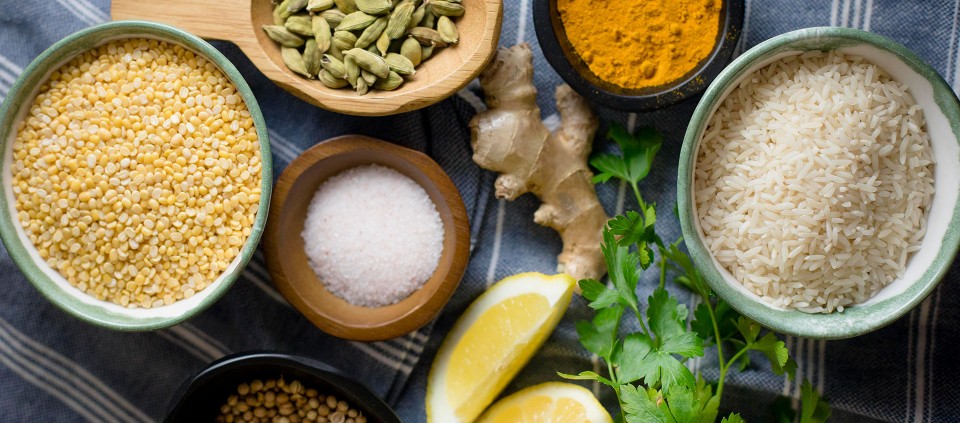How to Do a Spring Food Cleanse, Ayurveda Style

Have you ever been gung-ho about doing a cleanse, but found your willpower withering after a few days? Ayurveda has the recipe for success, says Erin Casperson, Dean of the Kripalu School of Ayurveda.
The key, she says, is to take a few days to “say goodbye to your usual eating habits” before you shift into full-on cleansing mode, instead of going cold turkey into a detox diet. Then, after the cleanse, take some time to rebuild your digestive fire and slowly reintroduce more robust foods, so you can reap the full benefits of the process.
By gradually transitioning in and out of the cleanse, you increase your chances of sticking to the most intense stage—the middle part. You also fine-tune your digestion, and your palate, along the way.
Erin recommends applying these principles to one of Ayurveda’s classical cleanses, which involves following a mono-diet for three to seven days. The star dish? Kitchari, a simple yet nourishing porridge composed of yellow mung dal beans, basmati rice, mild spices, and ghee.
Ease your way in.
Start by following an elimination diet for three days, Erin suggests. First, stop eating meat and takeout, if they're part of your usual diet, and start preparing home-cooked meals exclusively. Then, slowly wean yourself off harder-to-digest foods, such as sugar, white flour, dairy, wheat, alcohol, and caffeine, and stick to whole-grain, vegetarian dishes.
“In Ayurveda, we like slow changes that are sustainable,” Erin says. “If you start off by following an elimination diet, then when you start eating beans, vegetables, and eggs after your cleanse, they will seem tasty and exciting again.”
Ride out the resistance.
Now that your body and mind are primed for the cleanse, eat homemade kitchari for breakfast, lunch, and dinner for three to seven days to rest the digestive system. If you need some variety, spice up your breakfast kitchari with cinnamon, ginger, and cardamom. For lunch and dinner, whip up savory versions that appeal to your palate. Erin suggests adding turmeric, salt, pepper, and lemon to the dish. To stay hydrated, she recommends drinking water at room temperature or hotter. Herbal teas are permissible, too.
The challenge of following a mono-diet, Erin says, is our attachment to certain flavors, particularly the salty and sweet tastes. “Kitchari is a complete protein, so you have all the nutrition you need for a cleanse, but it gets boring after a day or two. This can be an opportunity to ask yourself, How am I using food to avoid or anesthetize pain? How do I use it to celebrate? To comfort myself at the end of the day?” If you’re willing to take a deeper look at your eating habits, a kitchari cleanse “can become revelatory,” she says.
Rebuild your digestive fire.
Even if you’re sick of the mono-diet by the end of your cleanse, Erin cautions, “Don’t jump straight into burger night. We want to exit in the same gentle, gradual way we came in.”
After a kitchari cleanse, “our digestive fire is weaker,” she explains. If you suddenly put hard-to-digest foods in your system again, you won’t reap the benefits of the cleanse and may end up with some digestive distress, such as constipation, gas, bloating. or heartburn. Instead, rebuild your digestive fire by taking a digestion-boosting rasayana, or rejuvenative substance (such as ginger), before every meal, as you slowly integrate more robust foods into your diet.
For the next three to five days, as you transition back into everyday eating—or until your appetite and elimination return to normal—drink one cup of ginger tea or eat one or two slices of a homemade ginger appetizer before each meal. To make the ginger appetizer, peel and slice one inch of ginger, put it in a small jar, then add a teaspoon or two of fresh lime juice and a couple pinches of salt.
At the same time, start reintroducing simple, home-cooked dishes, such as rice and steamed vegetables, veggie soups, and stews. Next, introduce some bean-based soups and stews, gradually increasing the size of the bean from mung to lentil to black and adzuki beans. As your digestive system gets stronger, add another protein to your meals in a relatively easy-to-digest form, such as tofu, chicken soup, or poached eggs. “The key is to eat just a few items at each meal,” Erin says. She also recommends having cooked fruits, such as apples and pears, between meals.
“After a mono-diet, even a simple soup tastes exciting,” says Erin. “Your taste buds change, your cravings change.” An Ayurvedic cleanse can break through our dietary habits, leaving space for new, healthier patterns. That’s what cleansing—and spring—are all about.
Browse detox and cleansing programs at Kripalu.
Sample more food-related videos, recipes, and articles: The Om of Yum
© Kripalu Center for Yoga & Health. All rights reserved. To request permission to reprint, please email editor@kripalu.org.